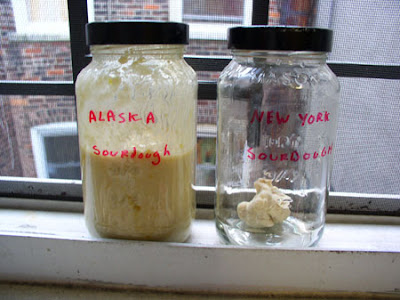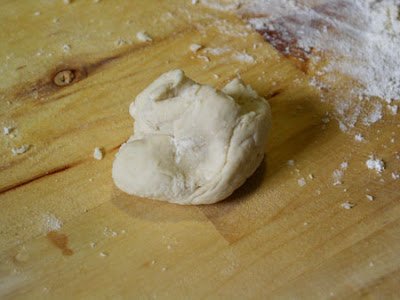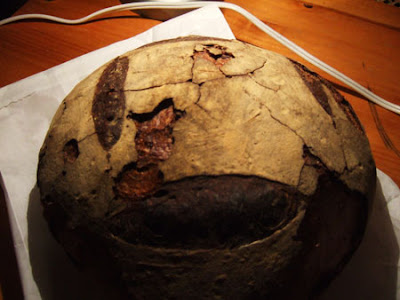After three days, the Alaskan Sourdough was ready to rock. It smelled sweet and yeasty. But I’m not really surprised, since the yeast culture is actually the result of the beer. Still, I’m looking forward to baking with it.What I’m really excited about is the New York Sourdough. As promised in the Science of Cooking Recipe, after three days the bread was dry on the outside, but inside it was bubbly with the arrival of transient yeasts making a home! And the best part? It does not smell like cat puke. It smelled “slightly sour,” the way it should.
Category Archives: bread
Alaska Sourdough vs. New York Sourdough
I am giving this sourdough starter thing one more chance. Please bare with me. I’m obsessed with making sourdough for two reasons: 1. Because I feel like a magician. Making bread appear–out of thin air!– in my mind is akin pulling a rabbit out of a hat. 2. Because I know it was done in the past, so I am determined to figure out how it was done. My mother thinks that some 19th century knowledge, like wild yeast starters, have just been lost to the ages. But I’m determined to rediscover it. So off I go to grow some pet yeasts.
This time, I’m attempting to make a yeast starter using two different methods. The first is courtesy of my friends Kristina and Chris in Alaska, who discovered a local woman who makes bags of pre-packaged yeast starter. They cornered her with questions on my behalf, and purchased a bag of her started as a gift to me.
“In 1849, the Boudin family struck culinary gold. Wild yeasts in the San Francisco air had imparted a unique tang to their traditional French bread, giving rise to “San Francisco sourdough French bread.” Today, the Boudin family’s initial recipe lives on in the hands and hearts of our expert bakers, with a portion of the original mother dough still starting each and every sourdough loaf we make.”
They still use the same recipe as they did in ’49, and little molecules of 1849 yeast are still awash in their starter! Awesome! I am really looking forward to visiting the bakery someday.
The Great Alaskan Meat-Off
I just came back from a two week trip to Alaska, where I staid with my friends Chris and Kristina in Girdwood, a suburb of Anchorage. I wanted to share with you some of the food I consumed.
Because of my continuing obsession with sourdough bread, Kristina took me to the  local bakery, The Bake Shop. As we arrived, so did a busload of tourists: The Shop seems to be the go-to breakfast stop for locals and tourists alike. I purchased a loaf of sourdough bread, which was surprisingly mild and delicious. Sourdough is associated with gold mining regions, like Alaska and San Francisco, because the miners could make it without taking a “sponge,” or yeast culture, with them. It could be created from yeast spores in the air.
local bakery, The Bake Shop. As we arrived, so did a busload of tourists: The Shop seems to be the go-to breakfast stop for locals and tourists alike. I purchased a loaf of sourdough bread, which was surprisingly mild and delicious. Sourdough is associated with gold mining regions, like Alaska and San Francisco, because the miners could make it without taking a “sponge,” or yeast culture, with them. It could be created from yeast spores in the air.
Kristina gifted me with a bag of locally-made sourdough starter, which gets going after you add a can of beer. I’m excited to try it, but I still want to try to create a starter from air-borne yeast.
I also had “Sweet Roll with a Side of Butter,” also made of sourdough, and also delicious. It had cinnamon and almonds, but also mysterious notes of brandy and anise. I had two over the extent of my stay.
 Clockwise, from left to right: Moose, Buffalo, Caribou, Elk, and Reindeer. Caribou and Reindeer are actually the same thing, the latter being wild and the former being farmed.
Clockwise, from left to right: Moose, Buffalo, Caribou, Elk, and Reindeer. Caribou and Reindeer are actually the same thing, the latter being wild and the former being farmed.In my second week, while on our way to Denali National Park, I finally acquired the object of my true desire: The Mc Kinley Mac. I had seen a poster for it as soon as I stepped off the plane, and had fantasized about it since. The Number 12 on the menu, this double-stacked McKinley Mac is only available in this state. Which is ok, because as I excited as I was to sample it, it just turned out to be a big gross burger.
Lastly, I made up a batch of Spruce Tea, after harvesting a few limbs from Alaska’s State Tree. It did not just taste like pine needles, but had a richer, spiced flavour. The batch I brewed was fairly weak, and I wanted to make a proper pot of tea when I returned to New York, but I forgot my bag branches in Girdwood. Perhaps Kristina will be kind enough to ship a few stateside–I’m curious to pass some along to my beer brewing friends, so they can make an authentic Spruce Beer.
At every restaurant we went to (three in the small town of Girdwood alone) the food was excellent, something I definitely didn’t expect when coming to Alaska. Additionally, there were very few chain restaurants; the ones that were there hadn’t even popped up until the last decade. Alaska’s relative isolation seems to have resulted in a bevy of independently owned restaurants with excellent food.
If you’re interested in my non-culinary Alaskan adventures, you should look at my photos here.
Continuing to Try to Make Yeast Appear from Thin Air

While I was vacationing at my summer home in Cleveland (I staid with my parents), my mom and I decided to try to grow a yeast culture. We were inspired by a book my friend Kristina sent me from Alaska: a little pamphlet about the history of sourdough bread. It carried these instructions on making your own starter:
2 cups Flour
Place ingredients in a glass bowl and blend well with a wooden or plastic spoon. Cover loosely with a clean towel (this allows air to enter the bowl so your starter can pick up wild yeasts from the environment) and place it in a warm spot. Once a day, remove half the starter and throw it away. To the remaining starter, add 1 cup flour and 1 cup warm water; stir in well until lumps are gone. After 3 or 4 days of replenishing the starter it should be bubbly and have a pleasant sour smell. It is then ready to be used immediately or it can be placed in a clean container with a loose cover and refrigerated for later use.
***
We followed the recipe, and place the bowl of flour and water out on the driveway to warm up. If you’ve been following this blog, you’ll know that last time I tried growing yeast in New York, I ended up with something that smelled like cat puke and looked worse. I hid it in the back of my refrigerator and eventually threw it away, too scared to make anything from it. This time wasn’t much better. Although the starter looked like a starter should, it again smelled exactly like cat puke. The stink of it made a friend dry heave.
However, having now attempted this operation twice with the same results, I was willing to try to make some cat puke bread. Mom, after listening to my father going on about some kind of deadly yeast, decided to throw it out. The decision was made for us when, after forgetting to bring the bowl in at night, some creature came along and ate it. I imagine the creature looked like this:
Yeast Infection!
 Left: The fresh starter. Right: After 48 hours.
Left: The fresh starter. Right: After 48 hours.
I never updated you on my yeast experiments from last month. Here’s the recipe I used to start my own yeast colony:

Needless to say, I haven’t tried to make anything from it. I’ve been too scared. And that’s where it stands.
Try This At Home: Make Yeast Appear–OUT OF THIN AIR!
History Dish Mondays: Rusks
Original recipe from American Cookery by Amelia Simmons
Modern Recipe from The Old Sturbridge Village Cookbook
1/4 pound butter
1 cup milk
7 eggs
6 tablespoons sugar
1 package yeast dissolved in 1/2 cup warm water
6-7 cups flour









